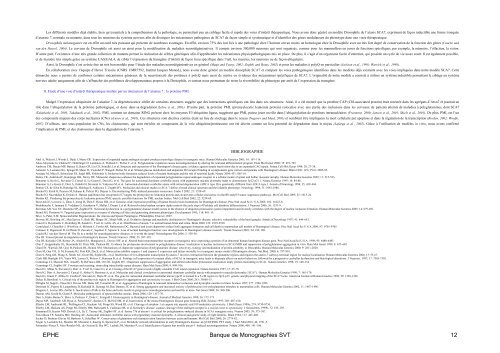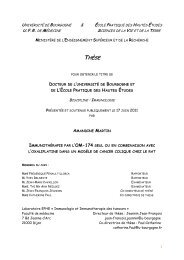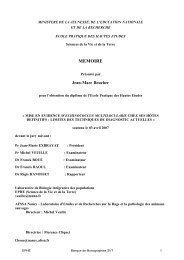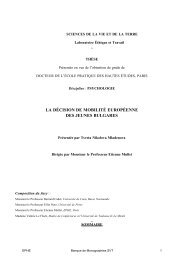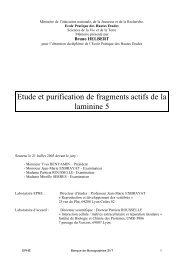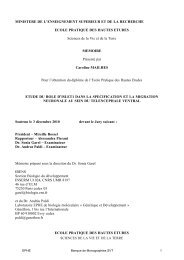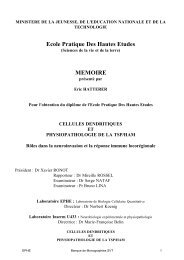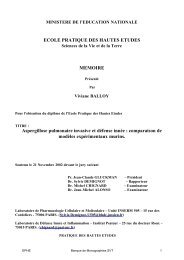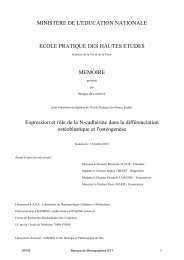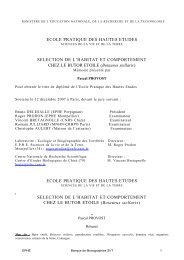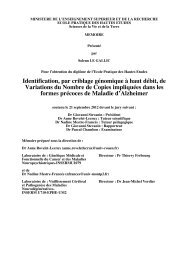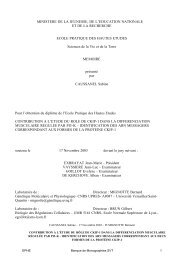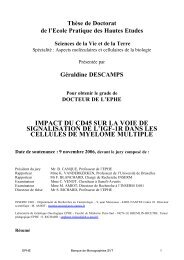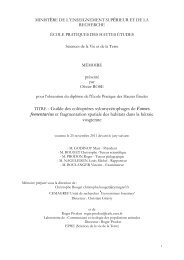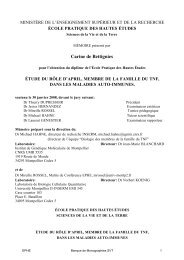Les différents modèles déjà établis, bien qu’essentiels à la compréhension de la pathologie, ne permettent pas un criblage facile et rapide des voies d’intérêt thérapeutique. Nous avons donc généré un modèle Drosophile de l’ataxie SCA7, exprimant de façon inductible une forme tronquée d’ataxine 7, normale ou mutante, dans tous les neurones du système nerveux afin de disséquer les mécanismes pathogènes de SCA7 de façon simple et systématique et d’identifier des gènes modulateurs du phénotype dans une visée thérapeutique. Drosophila melanogaster est en effet un outil très puissant qui présente de nombreux avantages. En effet, environ 75% des loci liés à une pathologie chez l’homme ont au moins un homologue chez la Drosophile avec un très fort degré de conservation de la fonction des gènes (Cauchi and van den Heuvel, 2006). Le cerveau de Drosophile est aussi un atout pour la modélisation de maladies neurodégénératives. Il compte environ 300,000 neurones qui sont organisés, comme pour les mammifères en zones de fonctions spécifiques, par exemple, la mémoire, l’olfaction, la vision. D’autre part, l’existence d’une très grande collection de mutants permet la réalisation de cribles génétiques afin d’appréhender les mécanismes physiopathologiques mis en place. De plus, il s’agit d’un organisme facile d’entretien, qui possède un cycle de vie assez court. Il est également possible, et de manière très simple grâce au système UAS/GAL4, de cibler l’expression du transgène d’intérêt de façon tissu spécifique dans l’œil, les muscles, les neurones ou de façon ubiquitaire. Ainsi, la Drosophile s’est avérée être un très bon modèle pour l’étude des maladies neurodégénératives en général (Muqit and Feany, 2002; Zoghbi and Botas, 2002) et pour les maladies à polyQ en particulier (Jackson et al., 1998; Warrick et al., 1998). En collaboration avec l’équipe d’Hervé Tricoire (CNRS UMR7592, Institut Jacques Monod,), nous avons donc généré un modèle drosophile SCA7 et comparé les voies pathogéniques identifiées dans les modèles déjà existants avec les voies impliquées dans notre modèle SCA7. Cette démarche nous a permis de confirmer certains mécanismes généraux de la neurotoxicité des protéines à polyQ mais aussi de mettre en évidence des mécanismes spécifiques de SCA7. L’originalité de notre modèle a consisté à utiliser un système inductible permettant le ciblage au système nerveux adulte uniquement afin de s’affranchir des problèmes développementaux propres à la Drosophile, et surtout nous permettant de tester la réversibilité du phénotype par arrêt de l’expression du transgène. II. Etude d’une voie d’intérêt thérapeutique médiée par un interacteur de l’ataxine 7 : la protéine PML Malgré l’expression ubiquitaire de l’ataxine 7, la dégénérescence ciblée de certaines structures suggère que des interactions spécifiques ont lieu dans ces structures. Ainsi, il a été montré que la protéine CAP (Cbl-associated protein) était recrutée dans les agrégats d’Atxn7 et jouerait un rôle dans l’ubiquitylation de la protéine pathologique, et donc dans sa dégradation (Lebre et al., 2001). D’autre part, la protéine PML (promyelocytic leukemia protein) colocalise avec une partie des inclusions dans les cerveaux de patients atteints de maladies à polyglutamines, dont SCA7 (Takahashi et al., 2003; Takahashi et al., 2002). PML contient un domaine RING présent chez les enzymes E3 ubiquitine ligase, suggérant que PML puisse jouer un rôle dans l’ubiquitylation de protéines intranucléaires (Freemont, 2000; Jensen et al., 2001; Shiels et al., 2001). De plus, PML est l’un des composants majeurs des corps nucléaires (CNs) (Jensen et al., 2001). Ces structures sont décrites comme étant un lieu de stockage dans le noyau (Negorev and Maul, 2001) et semblent être impliquées la mort cellulaire par apoptose et dans la régulation de la transcription (Borden, 2002; Woulfe, 2007). D’ailleurs, une sous-population de CNs, les clastosomes, qui sont enrichis en composants de la voie ubiquitine/protéasome ont été décrits comme un lieu potentiel de dégradation dans le noyau (Lafarga et al., 2002). Grâce à l’utilisation de modèles in vitro, nous avons confirmé l’implication de PML et des clastosomes dans la dégradation de l’ataxine 7. BIBLIOGRAPHIE Abel A, Walcott J, Woods J, Duda J, Merry DE. Expression of expanded repeat androgen receptor produces neurologic disease in transgenic mice. Human.Molecular.Genetics 2001; 10: 107-116. Abou-Sleymane G, Chalmel F, Helmlinger D, Lardenois A, Thibault C, Weber C, et al. Polyglutamine expansion causes neurodegeneration by altering the neuronal differentiation program. Hum Mol Genet 2006; 15: 691-703. Ambrose CM, Duyao MP, Barnes G, Bates GP, Lin CS, Srinidhi J, et al. Structure and expression of the Huntington's disease gene: evidence against simple inactivation due to an expanded CAG repeat. Somat.Cell Mol.Genet 1994; 20: 27-38. Antonini A, Leenders KL, Spiegel R, Meier D, Vontobel P, Weigell-Weber M, et al. Striatal glucose metabolism and dopamine D2 receptor binding in asymptomatic gene carriers and patients with Huntington's disease. Brain 1996; 119 ( Pt 6): 2085-95. Arrasate M, Mitra S, Schweitzer ES, Segal MR, Finkbeiner S. Inclusion body formation reduces levels of mutant huntingtin and the risk of neuronal death. Nature 2004; 431: 805-10. Bailey CK, Andriola IF, Kampinga HH, Merry DE. Molecular chaperones enhance the degradation of expanded polyglutamine repeat androgen receptor in a cellular model of spinal and bulbar muscular atrophy. Human.Molecular.Genetics 2002; 11: 515-523. Benomar A, Krols L, Stevanin G, Cancel G, Le Guern E, David G, et al. The gene for autosomal dominant cerebellar ataxia with pigmentary macular dystrophy maps to chromosome 3p12-p21.1. Nature.Genetics 1995; 10: 84-88. Benomar A, Le Guern E, Durr A, Ouhabi H, Stevanin G, Yahyaoui M, et al. Autosomal-dominant cerebellar ataxia with retinal degeneration (ADCA type II) is genetically different from ADCA type I. Annals.of.Neurology 1994; 35: 439-444. Benton CS, de Silva R, Rutledge SL, Bohlega S, Ashizawa T, Zoghbi HY. Molecular and clinical studies in SCA-7 define a broad clinical spectrum and the infantile phenotype. Neurology 1998; 51: 1081-1086. Bischof O, Kirsh O, Pearson M, Itahana K, Pelicci PG, Dejean A. Deconstructing PML-induced premature senescence. Embo J 2002; 21: 3358-69. Bischof O, Nacerddine K, Dejean A. Human papillomavirus oncoprotein E7 targets the promyelocytic leukemia protein and circumvents cellular senescence via the Rb and p53 tumor suppressor pathways. Mol Cell Biol 2005; 25: 1013-24. Borden KL. Pondering the promyelocytic leukemia protein (PML) puzzle: possible functions for PML nuclear bodies. Mol Cell Biol 2002; 22: 5259-69. Borovecki F, Lovrecic L, Zhou J, Jeong H, Then F, Rosas HD, et al. Genome-wide expression profiling of human blood reveals biomarkers for Huntington's disease. Proc Natl Acad Sci U S A 2005; 102: 11023-8. Boukhtouche F, Janmaat S, Vodjdani G, Gautheron V, Mallet J, Dusart I, et al. Retinoid-related orphan receptor alpha controls the early steps of Purkinje cell dendritic differentiation. J Neurosci 2006; 26: 1531-8. Bowman AB, Yoo SY, Dantuma NP, Zoghbi HY. Neuronal dysfunction in a polyglutamine disease model occurs in the absence of ubiquitin-proteasome system impairment and inversely correlates with the degree of nuclear inclusion formation. Human.Molecular.Genetics 2005; 14: 679-691. Brand AH, Perrimon N. Targeted gene expression as a means of altering cell fates and generating dominant phenotypes. Development 1993; 118: 401-15. Brice A, Pulst, S.M. Spinocerebellar Degenerations: the Ataxias and Spastic Paraplegias. Philadelphia: Elsevier, 2007. Browne SE, Bowling AC, MacGarvey U, Baik MJ, Berger SC, Muqit MM, et al. Oxidative damage and metabolic dysfunction in Huntington's disease: selective vulnerability of the basal ganglia. Annals.of.Neurology 1997; 41: 646-653. Cancel G, Duyckaerts C, Holmberg M, Zander C, Yvert G, Lebre AS, et al. Distribution of ataxin-7 in normal human brain and retina. Brain 2000; 123: 2519-2530. Carmichael J, Chatellier J, Woolfson A, Milstein C, Fersht AR, Rubinsztein DC. Bacterial and yeast chaperones reduce both aggregate formation and cell death in mammalian cell models of Huntington's disease. Proc Natl Acad Sci U S A 2000; 97: 9701-9705. Cattaneo E, Rigamonti D, Goffredo D, Zuccato C, Squitieri F, Sipione S. Loss of normal huntingtin function: new developments in Huntington's disease research. Trends Neurosci 2001; 24: 182-188. Cauchi RJ, van den Heuvel M. The fly as a model for neurodegenerative diseases: is it worth the jump? Neurodegener Dis 2006; 3: 338-56. Cha JH. Transcriptional dysregulation in Huntington's disease. Trends Neurosci. 2000; 23: 387-392. Cha JH, Kosinski CM, Kerner JA, Alsdorf SA, Mangiarini L, Davies SW, et al. Altered brain neurotransmitter receptors in transgenic mice expressing a portion of an abnormal human huntington disease gene. Proc.Natl.Acad.Sci.U.S.A. 1998; 95: 6480-6485. Chai Y, Koppenhafer SL, Shoesmith SJ, Perez MK, Paulson HL. Evidence for proteasome involvement in polyglutamine disease: localization to nuclear inclusions in SCA3/MJD and suppression of polyglutamine aggregation in vitro. Hum Mol Genet 1999; 8: 673-682. Chan HY, Warrick JM, Gray B, Paulson HL, Bonini NM. Mechanisms of chaperone suppression of polyglutamine disease: selectivity, synergy and modulation of protein solubility in Drosophila. Human.Molecular.Genetics 2000; 9: 2811-2820. Chen M, Ona VO, Li M, Ferrante RJ, Fink KB, Zhu S, et al. Minocycline inhibits caspase-1 and caspase-3 expression and delays mortality in a transgenic mouse model of Huntington disease. Nat.Med. 2000; 6: 797-801. Chen S, Peng GH, Wang X, Smith AC, Grote SK, Sopher BL, et al. Interference of Crx-dependent transcription by ataxin-7 involves interaction between the glutamine regions and requires the ataxin-7 carboxy-terminal region for nuclear localization. Human.Molecular.Genetics 2004; 13: 53-67. Clark HB, Burright EN, Yunis WS, Larson S, Wilcox C, Hartman B, et al. Purkinje cell expression of a mutant allele of SCA1 in transgenic mice leads to disparate effects on motor behaviors, followed by a progressive cerebellar dysfunction and histological alterations. J Neurosci. 1997; 17: 7385-7395. Cummings CJ, Mancini MA, Antalffy B, DeFranco DB, Orr HT, Zoghbi HY. Chaperone suppression of aggregation and altered subcellular proteasome localization imply protein misfolding in SCA1. Nature.Genetics 1998; 19: 148-154. Cummings CJ, Zoghbi HY. Fourteen and counting: unraveling trinucleotide repeat diseases. Hum Mol.Genet 2000; 9: 909-916. David G, Abbas N, Stevanin G, Durr A, Yvert G, Cancel G, et al. Cloning of the SCA7 gene reveals a highly unstable CAG repeat expansion. Nature.Genetics 1997; 17: 65-70. David G, Durr A, Stevanin G, Cancel G, Abbas N, Benomar A, et al. Molecular and clinical correlations in autosomal dominant cerebellar ataxia with progressive macular dystrophy ( SCA7 ). Human.Molecular.Genetics 1998; 7: 165-170. David G, Giunti P, Abbas N, Coullin P, Stevanin G, Horta W, et al. The gene for autosomal dominant cerebellar ataxia type II is located in a 5-cM region in 3p12-p13: genetic and physical mapping of the SCA7 locus. American.Journal.of.Human.Genetics 1996; 59: 1328-1336. Dehay B, Bertolotti A. Critical role of the proline-rich region in Huntingtin for aggregation and cytotoxicity in yeast. J Biol Chem 2006; 281: 35608-15. DiFiglia M, Sapp E, Chase KO, Davies SW, Bates GP, Vonsattel JP, et al. Aggregation of huntingtin in neuronal intranuclear inclusions and dystrophic neurites in brain. Science 1997; 277: 1990-1993. Dorsman JC, Pepers B, Langenberg D, Kerkdijk H, Ijszenga M, Den Dunnen JT, et al. Strong aggregation and increased toxicity of polyleucine over polyglutamine stretches in mammalian cells. Human.Molecular.Genetics 2002; 11: 1487-1496. Dragatsis I, Levine MS, Zeitlin S. Inactivation of hdh in the brain and testis results in progressive neurodegeneration and sterility in mice. Nat Genet 2000; 26: 300-306. Duenas AM, Goold R, Giunti P. Molecular pathogenesis of spinocerebellar ataxias. Brain 2006; 129: 1357-70. Durr A, Hahn-Barma V, Brice A, Pecheux C, Dode C, Feingold J. Homozygosity in Huntington's disease. Journal.of.Medical.Genetics 1999; 36: 172-173. Duyao MP, Auerbach AB, Ryan A, Persichetti F, Barnes GT, McNeil SM, et al. Inactivation of the mouse Huntington's disease gene homolog Hdh. Science 1995; 269: 407-410. Ellerby LM, Andrusiak RL, Wellington CL, Hackam AS, Propp SS, Wood JD, et al. Cleavage of atrophin-1 at caspase site aspartic acid 109 modulates cytotoxicity. J Biol.Chem. 1999a; 274: 8730-8736. Ellerby LM, Hackam AS, Propp SS, Ellerby HM, Rabizadeh S, Cashman NR, et al. Kennedy's disease: caspase cleavage of the androgen receptor is a crucial event in cytotoxicity. J Neurochem. 1999b; 72: 185-195. Emamian ES, Kaytor MD, Duvick LA, Zu T, Tousey SK, Zoghbi HY, et al. Serine 776 of ataxin-1 is critical for polyglutamine-induced disease in SCA1 transgenic mice. Neuron 2003; 38: 375-387. Enevoldson TP, Sanders MD, Harding AE. Autosomal dominant cerebellar ataxia with pigmentary macular dystrophy. A clinical and genetic study of eight families. Brain 1994; 117: 445-460. Escher D, Bodmer-Glavas M, Barberis A, Schaffner W. Conservation of glutamine-rich transactivation function between yeast and humans. Mol Cell Biol 2000; 20: 2774-82. Feigin A, Leenders KL, Moeller JR, Missimer J, Kuenig G, Spetsieris P, et al. Metabolic network abnormalities in early Huntington's disease: an [(18)F]FDG PET study. J Nucl Med 2001; 42: 1591-5. Fernandez-Funez P, Nino-Rosales ML, de Gouyon B, She WC, Luchak JM, <strong>Martin</strong>ez P, et al. Identification of genes that modify ataxin-1-induced neurodegeneration. Nature 2000; 408: 101-106. <strong>EPHE</strong> Banque de Monographies SVT 12
Ferrante RJ, Andreassen OA, Dedeoglu A, Ferrante KL, Jenkins BG, Hersch SM, et al. Therapeutic effects of coenzyme Q10 and remacemide in transgenic mouse models of Huntington's disease. J Neurosci 2002; 22: 1592-9. Ferrante RJ, Andreassen OA, Jenkins BG, Dedeoglu A, Kuemmerle S, Kubilus JK, et al. Neuroprotective effects of creatine in a transgenic mouse model of Huntington's disease. J Neurosci. 2000; 20: 4389-4397. Ferrante RJ, Kubilus JK, Lee J, Ryu H, Beesen A, Zucker B, et al. Histone deacetylase inhibition by sodium butyrate chemotherapy ameliorates the neurodegenerative phenotype in Huntington's disease mice. J Neurosci 2003; 23: 9418-27. Fogal V, Gostissa M, Sandy P, Zacchi P, Sternsdorf T, Jensen K, et al. Regulation of p53 activity in nuclear bodies by a specific PML isoform. Embo J 2000; 19: 6185-95. Freemont PS. RING for destruction? Curr.Biol. 2000; 10: R84-R87. Garden G, Truant, R., Ellerby, LM., LaSpada, AR. Spinocerebellarataxia type 7: Clinical features to cellular pathogenesis. In: Wells R, Ashizawa, T., editor. Genetic Instabilities And Neurological Diseases: Academic Press, 2006: 399-416. Garden GA, Libby RT, Fu YH, Kinoshita Y, Huang J, Possin DE, et al. Polyglutamine-expanded ataxin-7 promotes non-cell-autonomous purkinje cell degeneration and displays proteolytic cleavage in ataxic transgenic mice. J.Neurosci. 2002; 22: 4897-4905. Gardian G, Browne SE, Choi DK, Klivenyi P, Gregorio J, Kubilus JK, et al. Neuroprotective effects of phenylbutyrate in the N171-82Q transgenic mouse model of Huntington's disease. J Biol Chem 2005; 280: 556-63. Gargano JW, <strong>Martin</strong> I, Bhandari P, Grotewiel MS. Rapid iterative negative geotaxis (RING): a new method for assessing age-related locomotor decline in Drosophila. Exp Gerontol 2005; 40: 386-95. Gerber HP, Seipel K, Georgiev O, Hofferer M, Hug M, Rusconi S, et al. Transcriptional activation modulated by homopolymeric glutamine and proline stretches. Science 1994; 263: 808-811. Ghosh S, Feany MB. Comparison of pathways controlling toxicity in the eye and brain in Drosophila models of human neurodegenerative diseases. Human.Molecular.Genetics 2004; 13: 2011-2018. Gilad GM, Varon LE. Transglutaminase activity in rat brain: characterization, distribution, and changes with age. J Neurochem 1985; 45: 1522-6. Goldberg YP, Andrew SE, Theilmann J, Kremer B, Squitieri F, Telenius H, et al. Familial predisposition to recurrent mutations causing Huntington's disease: genetic risk to sibs of sporadic cases. Journal.of.Medical.Genetics 1993; 30: 987-990. Goldfarb DS, Gariepy J, Schoolnik G, Kornberg RD. Synthetic peptides as nuclear localization signals. Nature 1986; 322: 641-644. Goldfarb LG, Vasconcelos O, Platonov FA, Lunkes A, Kipnis V, Kononova S, et al. Unstable triplet repeat and phenotypic variability of spinocerebellar ataxia type 1. Annals.of.Neurology 1996; 39: 500-506. Gouw LG, Digre KB, Harris CP, Haines JH, Ptacek LJ. Autosomal dominant cerebellar ataxia with retinal degeneration: clinical, neuropathologic, and genetic analysis of a large kindred. Neurology 1994; 44: 1441-1447. Green H. Human genetic diseases due to codon reiteration: relationship to an evolutionary mechanism. Cell 1993; 74: 955-956. Greenfield JG. The Spino-cerebellar Degenerations: Oxford: Blackwell, 1954. Grignani F, Testa U, Rogaia D, Ferrucci PF, Samoggia P, Pinto A, et al. Effects on differentiation by the promyelocytic leukemia PML/RARalpha protein depend on the fusion of the PML protein dimerization and RARalpha DNA binding domains. Embo J 1996; 15: 4949-58. Gu M, Gash MT, Mann VM, Javoy-Agid F, Cooper JM, Schapira AH. Mitochondrial defect in Huntington's disease caudate nucleus. Annals.of.Neurology 1996; 39: 385-389. Gusella JF, MacDonald ME. Molecular genetics: unmasking polyglutamine triggers in neurodegenerative disease. Nat Rev Neurosci 2000; 1: 109-15. Harding AE. Friedreich's ataxia: a clinical and genetic study of 90 families with an analysis of early diagnostic criteria and intrafamilial clustering of clinical features. Brain 1981; 104: 589-620. Hardy J, Orr H. The genetics of neurodegenerative diseases. J Neurochem 2006; 97: 1690-9. Helmlinger D, Hardy S, Sasorith S, Klein F, Robert F, Weber C, et al. Ataxin-7 is a subunit of GCN5 histone acetyltransferase-containing complexes. Human.Molecular.Genetics 2004; 13: 1257-1265. Helmlinger D, Tora L, Devys D. Transcriptional alterations and chromatin remodeling in polyglutamine diseases. Trends Genet 2006; 22: 562-70. Hirayama K, Takayanagi T, Nakamura R, Yanagisawa N, Hattori T, Kita K, et al. Spinocerebellar degenerations in Japan: a nationwide epidemiological and clinical study. Acta Neurol.Scand. 1994; 153 (Suppl.): 1-22. Hodgson JG, Smith DJ, McCutcheon K, Koide HB, Nishiyama K, Dinulos MB, et al. Human huntingtin derived from YAC transgenes compensates for loss of murine huntingtin by rescue of the embryonic lethal phenotype. Human.Molecular.Genetics 1996; 5: 1875-1885. Holmberg M, Duyckaerts C, Durr A, Cancel G, Gourfinkel-An I, Damier P, et al. Spinocerebellar ataxia type 7 (SCA7): a neurodegenerative disorder with neuronal intranuclear inclusions. Human.Molecular.Genetics 1998; 7: 913-918. Housman D. Gain of glutamines, gain of function? Nature.Genetics 1995; 10: 3-4. Igarashi S, Koide R, Shimohata T, Yamada M, Hayashi Y, Takano H, et al. Suppression of aggregate formation and apoptosis by transglutaminase inhibitors in cells expressing truncated DRPLA protein with an expanded polyglutamine stretch. Nature.Genetics 1998; 18: 111-117. Ishikawa K, Fujigasaki H, Saegusa H, Ohwada K, Fujita T, Iwamoto H, et al. Abundant expression and cytoplasmic aggregations of [alpha]1A voltage- dependent calcium channel protein associated with neurodegeneration in spinocerebellar ataxia type 6. Hum Mol Genet 1999; 8: 1185-1193. Jackson GR, Salecker I, Dong X, Yao X, Arnheim N, Faber PW, et al. Polyglutamine-expanded human huntingtin transgenes induce degeneration of Drosophila photoreceptor neurons. Neuron 1998; 21: 633-642. Jackson SM, Whitworth AJ, Greene JC, Libby RT, Baccam SL, Pallanck LJ, et al. A SCA7 CAG/CTG repeat expansion is stable in Drosophila melanogaster despite modulation of genomic context and gene dosage. Gene 2005. Janer A, <strong>Martin</strong> E, Muriel MP, Latouche M, Fujigasaki H, Ruberg M, et al. PML clastosomes prevent nuclear accumulation of mutant ataxin-7 and other polyglutamine proteins. J Cell Biol. 2006; 174: 65-76. Jassim OW, Fink JL, Cagan RL. Dmp53 protects the Drosophila retina during a developmentally regulated DNA damage response. Embo J 2003; 22: 5622-32. Javed A, Reder AT. Therapeutic role of beta-interferons in multiple sclerosis. Pharmacol Ther 2006; 110: 35-56. Jensen K, Shiels C, Freemont PS. PML protein isoforms and the RBCC/TRIM motif. Oncogene 2001; 20: 7223-33. Jonasson J, Strom AL, Hart P, Brannstrom T, Forsgren L, Holmberg M. Expression of ataxin-7 in CNS and non-CNS tissue of normal and SCA7 individuals. Acta Neuropathol.(Berl) 2002; 104: 29-37. Kahlem P, Green H, Djian P. Transglutaminase action imitates Huntington's disease: selective polymerization of Huntingtin containing expanded polyglutamine. Mol.Cell 1998; 1: 595-601. Kahlem P, Terre C, Green H, Djian P. Peptides containing glutamine repeats as substrates for transglutaminase-catalyzed cross-linking: relevance to diseases of the nervous system. Proc.Natl.Acad.Sci.U.S.A. 1996; 93: 14580-14585. Karpuj MV, Garren H, Slunt H, Price DL, Gusella J, Becher MW, et al. Transglutaminase aggregates huntingtin into nonamyloidogenic polymers, and its enzymatic activity increases in Huntington's disease brain nuclei. Proc.Natl.Acad.Sci.U.S.A. 1999; 96: 7388-7393. Kashi Y, King D, Soller M. Simple sequence repeats as a source of quantitative genetic variation. Trends Genet 1997; 13: 74-8. Kastner P, Perez A, Lutz Y, Rochette-Egly C, Gaub MP, Durand B, et al. Structure, localization and transcriptional properties of two classes of retinoic acid receptor alpha fusion proteins in acute promyelocytic leukemia (APL): structural similarities with a new family of oncoproteins. Embo J 1992; 11: 629-42. Katsuno M, Adachi H, Kume A, Li M, Nakagomi Y, Niwa H, et al. Testosterone reduction prevents phenotypic expression in a transgenic mouse model of spinal and bulbar muscular atrophy. Neuron 2002; 35: 843-854. Katti MV, Sami-Subbu R, Ranjekar PK, Gupta VS. Amino acid repeat patterns in protein sequences: their diversity and structural-functional implications. Protein Sci 2000; 9: 1203-9. Kaytor MD, Duvick LA, Skinner PJ, Koob MD, Ranum LP, Orr HT. Nuclear localization of the spinocerebellar ataxia type 7 protein, ataxin-7. Hum Mol Genet 1999; 8: 1657-1664. Kaytor MD, Wilkinson KD, Warren ST. Modulating huntingtin half-life alters polyglutamine-dependent aggregate formation and cell toxicity. J Neurochem 2004; 89: 962-73. Kazemi-Esfarjani P, Benzer S. Genetic suppression of polyglutamine toxicity in Drosophila. Science 2000; 287: 1837-1840. Kim M, Lee HS, Laforet G, McIntyre C, <strong>Martin</strong> EJ, Chang P, et al. Mutant huntingtin expression in clonal striatal cells: dissociation of inclusion formation and neuronal survival by caspase inhibition. J Neurosci 1999a; 19: 964-973. Kim SY, Grant P, Lee JH, Pant HC, Steinert PM. Differential expression of multiple transglutaminases in human brain. Increased expression and cross-linking by transglutaminases 1 and 2 in Alzheimer's disease. J Biol Chem 1999b; 274: 30715-21. Kim TW, Tanzi RE. Neuronal intranuclear inclusions in polyglutamine diseases: nuclear weapons or nuclear fallout? Neuron 1998; 21: 657-659. Klement IA, Skinner PJ, Kaytor MD, Yi H, Hersch SM, Clark HB, et al. Ataxin-1 nuclear localization and aggregation: role in polyglutamine- induced disease in SCA1 transgenic mice. Cell 1998; 95: 41-53. Koeppen AH, Barron, K.D. The neuropathology of olivopontocerebellar atrophy. In: Duvoisin RC, Plaitakais, A., editor. The olivopontocerebellar atrophies. New York: Raven Press, 1984: 13-38. La Spada AR, Fu Y, Sopher BL, Libby RT, Wang X, Li LY, et al. Polyglutamine-expanded ataxin-7 antagonizes crx function and induces cone-rod dystrophy in a mouse model of sca7. Neuron 2001; 31: 913-927. La Spada AR, Wilson EM, Lubahn DB, Harding AE, Fischbeck KH. Androgen receptor gene mutations in X-linked spinal and bulbar muscular atrophy. Nature 1991; 352: 77-79. Lafarga M, Berciano MT, Pena E, Mayo I, Castano JG, Bohmann D, et al. Clastosome: a subtype of nuclear body enriched in 19S and 20S proteasomes, ubiquitin, and protein substrates of proteasome. Mol Biol Cell 2002; 13: 2771-82. Lam YC, Bowman AB, Jafar-Nejad P, Lim J, Richman R, Fryer JD, et al. ATAXIN-1 interacts with the repressor Capicua in its native complex to cause SCA1 neuropathology. Cell 2006; 127: 1335-47. Latouche M, Lasbleiz C, <strong>Martin</strong> E, Monnier V, Debeir T, Mouatt-Prigent A, et al. A conditional pan-neuronal Drosophila model of spinocerebellar ataxia 7 with a reversible adult phenotype suitable for identifying modifier genes. J.Neurosci. 2007; 27: 2483-2492. Lebre AS, Jamot L, Takahashi J, Spassky N, Leprince C, Ravise N, et al. Ataxin-7 interacts with a Cbl-associated protein that it recruits into neuronal intranuclear inclusions. Hum Mol Genet 2001; 10: 1201-1213. Lesort M, Chun W, Johnson GV, Ferrante RJ. Tissue transglutaminase is increased in Huntington's disease brain. J.Neurochem. 1999; 73: 2018-2027. Li F, Macfarlan T, Pittman RN, Chakravarti D. Ataxin-3 is a histone-binding protein with two independent transcriptional corepressor activities. J Biol Chem 2002; 277: 45004-12. Lin X, Antalffy B, Kang D, Orr HT, Zoghbi HY. Polyglutamine expansion down-regulates specific neuronal genes before pathologic changes in SCA1. Nat.Neurosci. 2000; 3: 157-163. Lindblad K, Savontaus ML, Stevanin G, Holmberg M, Digre K, Zander C, et al. An expanded CAG repeat sequence in spinocerebellar ataxia type 7. Genome Res. 1996; 6: 965-971. Luthi-Carter R, Strand A, Peters NL, Solano SM, Hollingsworth ZR, Menon AS, et al. Decreased expression of striatal signaling genes in a mouse model of Huntington's disease. Hum Mol.Genet 2000; 9: 1259-1271. Mangiarini L, Sathasivam K, Mahal A, Mott R, Seller M, Bates GP. Instability of highly expanded CAG repeats in mice transgenic for the Huntington's disease mutation. Nature.Genetics 1997; 15: 197-200. Mangiarini L, Sathasivam K, Seller M, Cozens B, Harper A, Hetherington C, et al. Exon 1 of the HD gene with an expanded CAG repeat is sufficient to cause a progressive neurological phenotype in transgenic mice. Cell 1996; 87: 493-506. Mar Alba M, Santibanez-Koref MF, Hancock JM. Amino acid reiterations in yeast are overrepresented in particular classes of proteins and show evidence of a slippage-like mutational process. J Mol Evol 1999; 49: 789-97. Marsh JL, Walker H, Theisen H, Zhu YZ, Fielder T, Purcell J, et al. Expanded polyglutamine peptides alone are intrinsically cytotoxic and cause neurodegeneration in Drosophila. Hum Mol Genet 2000; 9: 13-25. <strong>Martin</strong>-Aparicio E, Yamamoto A, Hernandez F, Hen R, Avila J, Lucas JJ. Proteasomal-dependent aggregate reversal and absence of cell death in a conditional mouse model of Huntington's disease. J Neurosci 2001; 21: 8772-81. Mastrogiacomo F, LaMarche J, Dozic S, Lindsay G, Bettendorff L, Robitaille Y, et al. Immunoreactive levels of alpha-ketoglutarate dehydrogenase subunits in Friedreich's ataxia and spinocerebellar ataxia type 1. Neurodegeneration. 1996; 5: 27-33. Matilla A, Gorbea C, Einum DD, Townsend J, Michalik A, Van Broeckhoven C, et al. Association of ataxin-7 with the proteasome subunit S4 of the 19S regulatory complex. Human.Molecular.Genetics 2001; 10: 2821-2831. Matilla A, Roberson ED, Banfi S, Morales J, Armstrong DL, Burright EN, et al. Mice lacking ataxin-1 display learning deficits and decreased hippocampal paired-pulse facilitation. J Neurosci. 1998; 18: 5508-5516. Matsuishi T, Sakai T, Naito E, Nagamitsu S, Kuroda Y, Iwashita H, et al. Elevated cerebrospinal fluid lactate/pyruvate ratio in Machado- Joseph disease. Acta Neurol.Scand. 1996; 93: 72-75. Matsumura R, Futamura N, Fujimoto Y, Yanagimoto S, Horikawa H, Suzumura A, et al. Spinocerebellar ataxia type 6. Molecular and clinical features of 35 Japanese patients including one homozygous for the CAG repeat expansion. Neurology 1997; 49: 1238-1243. McMahon SJ, Pray-Grant MG, Schieltz D, Yates JR, III, Grant PA. Polyglutamine-expanded spinocerebellar ataxia-7 protein disrupts normal SAGA and SLIK histone acetyltransferase activity. Proc.Natl.Acad.Sci.U.S.A 2005; 102: 8478-8482. Merienne K, Friedman J, Akimoto M, Abou-Sleymane G, Weber C, Swaroop A, et al. Preventing polyglutamine-induced activation of c-Jun delays neuronal dysfunction in a mouse model of SCA7 retinopathy. Neurobiol Dis 2007; 25: 571-81. Michalik A, <strong>Martin</strong> JJ, Van Broeckhoven C. Spinocerebellar ataxia type 7 associated with pigmentary retinal dystrophy. Eur J Hum Genet 2004; 12: 2-15. Minamiyama M, Katsuno M, Adachi H, Waza M, Sang C, Kobayashi Y, et al. Sodium butyrate ameliorates phenotypic expression in a transgenic mouse model of spinal and bulbar muscular atrophy. Hum Mol Genet 2004; 13: 1183-92. Moseley ML, Zu T, Ikeda Y, Gao W, Mosemiller AK, Daughters RS, et al. Bidirectional expression of CUG and CAG expansion transcripts and intranuclear polyglutamine inclusions in spinocerebellar ataxia type 8. Nat Genet 2006; 38: 758-69. Muqit MM, Feany MB. Modelling neurodegenerative diseases in Drosophila: a fruitful approach? Nat Rev Neurosci 2002; 3: 237-43. Mushegian AR, Vishnivetskiy SA, Gurevich VV. Conserved phosphoprotein interaction motif is functionally interchangeable between ataxin-7 and arrestins. Biochemistry 2000; 39: 6809-6813. Myers RH, Leavitt J, Farrer LA, Jagadeesh J, McFarlane H, Mastromauro CA, et al. Homozygote for Huntington disease. American.Journal.of.Human.Genetics 1989; 45: 615-618. Nakamura K, Jeong SY, Uchihara T, Anno M, Nagashima K, Nagashima T, et al. SCA17, a novel autosomal dominant cerebellar ataxia caused by an expanded polyglutamine in TATA-binding protein. Human.Molecular.Genetics 2001; 10: 1441-1448. Nasir J, Floresco SB, O'Kusky JR, Diewert VM, Richman JM, Zeisler J, et al. Targeted disruption of the Huntington's disease gene results in embryonic lethality and behavioral and morphological changes in heterozygotes. Cell 1995; 81: 811-823. Negorev D, Maul GG. Cellular proteins localized at and interacting within ND10/PML nuclear bodies/PODs suggest functions of a nuclear depot. Oncogene 2001; 20: 7234-42. <strong>EPHE</strong> Banque de Monographies SVT 13


